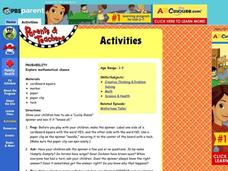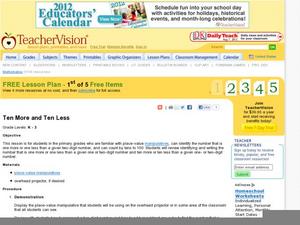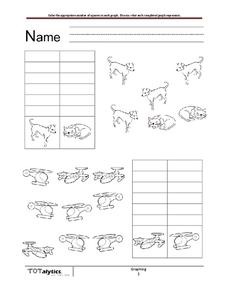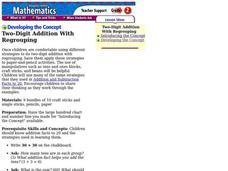Curated OER
Two-Column Chart
In this two-column chart worksheet, learners use the blank graphic organizer template as instructed by their teacher. This t-chart may be used for a variety of classroom activities.
Ed Migliore
Linear Equations in Two Variables
This traditional textbook style unit includes vocabulary, a direct explanation section, examples, practice problems that directly line up with the explanations and examples, and a unit summary review and practice problems. Learners get...
Curated OER
Tally Chart/Pictograph
In this graphic organizer worksheet, students can record their own data on this tally chart/pictograph. There are two columns and six rows with room for a title.
Houghton Mifflin Harcourt
Graphs from Patterns
Fifth graders analyze patterns and begin looking at function tables. This is a pertinent preparation for graphing patterns. In fact, consider giving your class a piece of graph paper and then teach them how!
Curated OER
2-D polygons
A hands-on activity uses the Zome modeling system, and helps young geometers either learn or review their knowledge of polygons. Students build as many different 2-dimensional polygons as possible: triangle, square, rectangle, pentagon,...
Curated OER
Multiplication Charts, Multiply By 2-10
In this multiplication chart worksheet, learners will solve multiplication problems where they complete a two column chart. On each chart one of the factors is two through 10. The other factor may be any number because it is left blank.
Math Drills
Multiplication Five Minute Frenzy (E)
How fast can you multiply one- and two-digit numbers? Have kids keep track of their success as they work on these math drills. Each grid features ten numbers on the x axis that kids can multiply by the ten numbers on the y axis.
Curated OER
Reading Tables
Who is two years younger than Meg? Who is older than Paul, but not Kinta? Scholars practice reading tables as they answer comprehension questions based on three sets of data. First, they examine a table depicting ages, then favorite...
Curated OER
Making Simple Conversions
Young scholars explore the concept of measurement as it relates to equivalencies. They complete simple conversions using visual models of measurement units, and record their answers in a two-column table.
Curated OER
Tables
Can you read this table? Learners begin to comprehend data analysis through examining two simple tables and answering comprehension questions. The first gives characteristics about three animals in yes-or-no format (i.e. "eats insects,"...
Curated OER
Graphs
For beginners to picture graphs this is the perfect resource. They analyze two bar graphs that break down data visually so scholars can actually count the number in each column. For the first, they fill in how many of each type of pet is...
Curated OER
Probability
Here is a very clever way of teaching young mathematicians the concept of probability. A spinner is made that has two outcomes, yes and no. A chart is made that has two columns that are labeled Correct and Incorrect. The teacher asks a...
Curriculum Corner
Second Grade Summer Math Practice Book
Stop the summer lag with a set of second grade Common Core based math practice sheets. Learners fill in hundreds charts with missing numbers up to 1,000. They practice writing numbers in standard, expanded, and word form. Children also...
Curated OER
Fraction Spelling
An interesting take on spelling practice is included here! Emerging spellers take their weekly spelling list and create a three-column chart. In the first column, they write the word itself. In the second column, they write how many...
Curated OER
Goldentail's Rounding Railroad
In this number puzzle activity, students solve 24 equations in each of two sets of multiplication and division problems. They circle each answer and round them to the nearest whole number. They use the secret code that is shown in a box...
Curated OER
100 Or Bust!
Elementary schoolers use their understanding of place value to develop a strategy for a number game. In this lesson, pupils use place value to play "100 or Bust" and figure out a good winning strategy. These kinds of math games are...
Illustrative Mathematics
Buying Protein Bars and Magazines
Packing for a trip? This activity allows learners to decide how many magazines and protein bars they can buy with twenty dollars. They can organize their work in a chart to track how many items they can purchase. There are two different...
Curated OER
Ten More and Ten Less
Get learners to analyze two-digit numbers based on place value, and use manipulatives to add and subtract both 1 and 10. A place value chart is available, and you can project it during guided practice. Through visualizing...
Curated OER
Addition Grid Chart
In this addition worksheet, students fill in the squares in an addition grid. Students add the two numbers in the columns and rows. The addition facts are from 0 to 10.
Mrs. Glosser's Math Goodies
Number Theory Worksheet 3
A nine-row data table has novice number crunchers fill in columns for the greatest common factor, least common multiple, product of the two, and product of numbers. The pairs of numbers to work with are all single- and double-digit...
DK Publishing
Sneaky Snake: Numbers, Part 2
Don't let these sneaky snakes fool your little learners! A number chart lists numbers 1 - 100, but several snakes are blocking many of the numbers. Mathematicians figure out which numbers are hidden and fill them in next to the...
Curated OER
How Many?
How many cats are there? Dogs? As learners examine a set of images, they fill in a chart to indicate how many of each image there are. In the first series, there are four dogs and two cats. In the second, there are three planes and six...
Curated OER
Two-Digit Addition With Regrouping
Second graders practice two-digit addition with regrouping. In this addition lesson, 2nd graders use craft sticks to solve two-digit regrouping problems. Students solve problems on the chalkboard.
Curated OER
Five Minute Adding Frenzy (A)
In this five minute adding frenzy worksheet, students problem solve one hundred addition equations within five minutes by writing the sum of the column and row numbers in each space.























